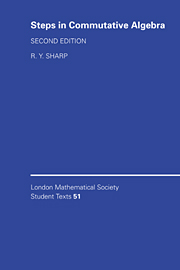Book contents
- Frontmatter
- Contents
- Preface to the 1st Edition
- Preface to the 2nd Edition
- 1 Commutative rings and subrings
- 2 Ideals
- 3 Prime ideals and maximal ideals
- 4 Primary decomposition
- 5 Rings of fractions
- 6 Modules
- 7 Chain conditions on modules
- 8 Commutative Noetherian rings
- 9 More module theory
- 10 Modules over principal ideal domains
- 11 Canonical forms for square matrices
- 12 Some applications to field theory
- 13 Integral dependence on subrings
- 14 Afflne algebras over fields
- 15 Dimension theory
- 16 Regular sequences and grade
- 17 Cohen–Macaulay rings
- Bibliography
- Index
Preface to the 2nd Edition
Published online by Cambridge University Press: 06 January 2010
- Frontmatter
- Contents
- Preface to the 1st Edition
- Preface to the 2nd Edition
- 1 Commutative rings and subrings
- 2 Ideals
- 3 Prime ideals and maximal ideals
- 4 Primary decomposition
- 5 Rings of fractions
- 6 Modules
- 7 Chain conditions on modules
- 8 Commutative Noetherian rings
- 9 More module theory
- 10 Modules over principal ideal domains
- 11 Canonical forms for square matrices
- 12 Some applications to field theory
- 13 Integral dependence on subrings
- 14 Afflne algebras over fields
- 15 Dimension theory
- 16 Regular sequences and grade
- 17 Cohen–Macaulay rings
- Bibliography
- Index
Summary
The decade since the appearance of the first edition of this book has seen the publication of some important books in commutative algebra, such as D. Eisenbud's ‘Commutative algebra with a view toward algebraic geometry’ [5], which stresses the geometric heritage of the subject, and W. Bruns' and J. Herzog's ‘Cohen–Macaulay rings’ [2], There is therefore even more motivation to encourage young people to study commutative algebra, and so, in my opinion, the raison d'être for this book – to provide ‘stepping stones’ to help young people into the subject so that they can go on to study more advanced books with confidence – is as strong as ever.
This second edition contains two new chapters, namely Chapter 16 on ‘Regular sequences and grade’ and Chapter 17 on ‘Cohen–Macaulay rings’. These chapters are just ideal-theoretic introductions to the topics of their titles: a complete treatment of them would involve significant use of homological algebra, and that is beyond the scope of the book. Nevertheless, there are some ideal-theoretic aspects which can be developed very satisfactorily within the framework of the book, and, indeed, which provide good applications of ideas developed in earlier chapters; it is those aspects which receive attention in these new chapters. It is hoped that they will whet the reader's appetite to explore Bruns' and Herzog's [2], a book which provides ample evidence of the importance of the Cohen–Macaulay condition.
I have taken the opportunity to make a few improvements to, and correct a small number of misprints in, the fifteen chapters which formed the first edition.
- Type
- Chapter
- Information
- Steps in Commutative Algebra , pp. xiiPublisher: Cambridge University PressPrint publication year: 2001

